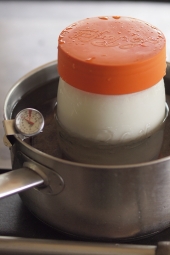
 14
14




Sourdough Without Fail Natural Small Batch Cheesemaking A Year in an Off-Grid Kitchen Backyard Dairy Goats My website @NourishingPermaculture @KateDownham






 7
7





 9
9




Hans Albert Quistorff, LMT projects on permies Hans Massage Qberry Farm magnet therapy gmail hquistorff
 1
1




Kathleen Sanderson wrote:Adding to the benefits of home dairy, surplus milk, whey, failed cheeses, etc., can all be used to supplement the feed of your other animals, too. If you can give your egg-layers a little milk every day, they won't need so much expensive store-bought feed. And a milk supplement will allow them to lay well on free-range, and/or kitchen scraps, where otherwise the number of eggs would drop off. The calcium in the milk is good for the egg shells, too. (Layers can be ducks, as well as chickens.)
Milk is commonly used to supplement pigs, and can also be given to your farm dogs (start with small amounts to see how they tolerate it, but most breeds bred for farm work should be able to handle some milk in their diet). I've even heard of rabbits being supplemented with milk.
Surplus milk is also ideal for raising bottle calves or lambs or goat kids for adding to your meat supply. A good milk cow should be able to raise her own calf, plus one or two extras, and still supply milk for the household.
Sourdough Without Fail Natural Small Batch Cheesemaking A Year in an Off-Grid Kitchen Backyard Dairy Goats My website @NourishingPermaculture @KateDownham






 4
4




 1
1





~Karen Lee Mack
Moving to south Georgia FALL 2024!!

|
See where your hand is? Not there. It's next to this tiny ad:
The new purple deck of permaculture playing cards
https://www.kickstarter.com/projects/paulwheaton/garden-cards
|






